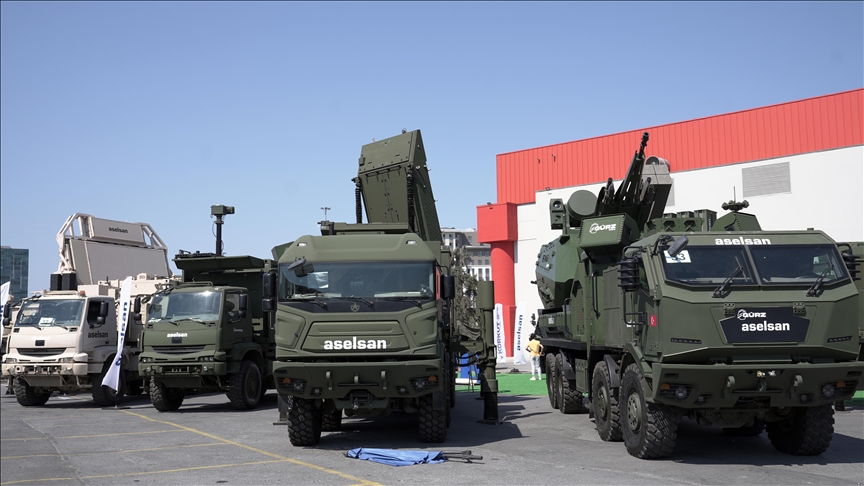How Trump is reshaping Taiwan’s strategic calculus
- Taipei sees US chip pressure as unfeasible and risky despite security dependence, say experts
- ‘Taiwan sits on the chessboard of US-China competition … There is little room for hedging,’ says Shun-wen Wang, a professor at Taiwan’s National University of Kaohsiung
ISTANBUL
As Washington and Beijing move to stabilize their relations, Taiwan is facing a convergence of pressures from its most important security partner. President Donald Trump’s push to relocate a large share of Taiwan’s semiconductor manufacturing to the US, new tariff rules, and demands for sharply higher defense spending have placed the island in its most complex position in years.
Taiwan supplies essential chips to global markets, including the US, and is home to the world’s most advanced semiconductor ecosystem. But Trump wants 50% of Taiwanese chip production moved to American soil – a proposal Taipei is resisting even as it faces 20% US tariffs.
The push comes as Trump has publicly expressed confidence that Chinese President Xi Jinping will not use force against Taiwan. The two leaders met last month in South Korea for their first face-to-face summit since 2019 – a meeting that, according to Trump, did not address Taiwan.
Experts told Anadolu that the competing pressures over chips, tariffs and defense spending are now converging into one of the most complex moments for Taiwan’s ties with its most important security partner.
“Taiwan sits on the chessboard of US-China competition,” said Shun-wen Wang, a professor at Taiwan’s National University of Kaohsiung. “There is little room for hedging.”
Chips at the core of the dispute
Trump’s insistence that Taiwan shift half of its chip manufacturing to the US is widely viewed in Taipei as unrealistic, risky, and destabilizing.
“Taiwan’s strength lies in high technology,” Chien-Yu Shih, associate research fellow at the Taipei-based Institute for National Defense and Security Research, told Anadolu.
Giving in to such demands “will not be acceptable to Taiwan’s authorities,” Shih said, while also adding that Taipei “currently has no alternative” to the US for security.
Shih said Taiwan is not rejecting the proposal outright, but much of it cannot be implemented.
“Taiwan possesses a complete semiconductor manufacturing ecosystem, whereas the US lacks such an industrial chain and cannot easily relocate,” Shih explained. “Semiconductor workers require specialized high-tech expertise and extensive training, not ordinary labor – roles American workers cannot immediately fill.”
Shih added that even if the US were to expand capacity rapidly, relocating high-tech industrial chains could take more than a decade.
“The US currently lacks the necessary high-tech workforce and supporting infrastructure to accommodate such a shift,” he said.
Taiwan Semiconductor Manufacturing Company (TSMC) has pledged $65 billion for its US facilities under construction in Arizona. However, these factories will not produce the company’s most advanced chips ahead of its plants in Taiwan.
Tariffs and defense spending demands
Beyond the chip debate, Taiwan is grappling with new US tariffs. Trump’s 20% rate on Taiwanese imports is lower than the 32% he threatened in April, but remains noticeably higher than the 15% tariffs applied to similar goods from Japan, South Korea, and other US allies.
In August, Taiwan’s leader William Lai Ching-te described the tariffs as “provisional” and voiced hope they could be lowered through negotiation.
Shih said the tariff talks “have not significantly impacted the political and security relationship,” but warned the economic burden will fall unevenly.
“Industries such as bicycles, textiles, and machine tools may be substantially affected,” he said.
Taiwan’s export-dependent sectors, he added, are likely to feel the effects quickly, and the burden could generate “dissatisfaction within Taiwanese society.”
Trump has also demanded that Taipei raise defense spending to as much as 10% of its $884 billion gross domestic product – a level far beyond what Taiwan currently allocates.
Lai’s administration has proposed increasing next year’s defense budget to around 3% of GDP, or about $31.1 billion.
But Shih expects the figure to climb even further.
“Taiwan’s defense budget will soon rise to 5% of GDP or more,” he said. “While boosting defense spending has nothing to do with trade tariff wars, this is also the development the United States hopes to see.”
During Trump’s first term, the US approved roughly $18 billion in arms sales to Taiwan.
‘The larger issue is trust’
The Trump administration is simultaneously negotiating a trade deal with China, one of America’s largest economic partners, even as it imposes tariffs across both allies and rivals.
“The larger issue is trust,” said Beijing-based Asia expert Einar Tangen. “Donald Trump is not perceived as trustworthy, and neither are current elites in Washington.”
Shih said the US-China confrontation has become structural.
“It is a global-level power struggle, and neither side will readily concede,” he said. “Taiwan naturally does not wish to see the US and China using it as a bargaining chip.”
Wang said Taiwan has little strategic freedom.
“Given Taiwan’s strategically important position and its need for security assurance, it does not have many options but to stand together with its strategic allies,” he said.
Ali Wyne, senior research and advocacy advisor for US-China relations at the International Crisis Group, told Anadolu that Trump has “evinced little concern for Taiwan’s security.”
He said Trump appears “interested in a narrow deal focused mainly on restoring a more functional trading relationship” with China.
Xi, he added, “seems interested in a more expansive deal that would entail security concessions from the US.”
Anadolu Agency website contains only a portion of the news stories offered to subscribers in the AA News Broadcasting System (HAS), and in summarized form. Please contact us for subscription options.




